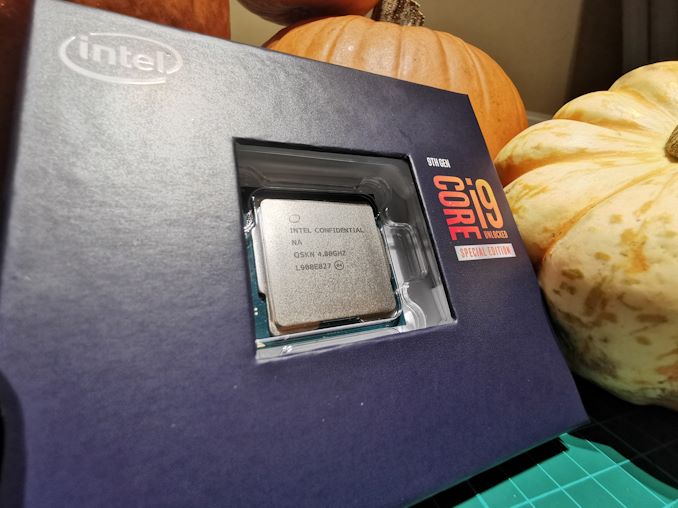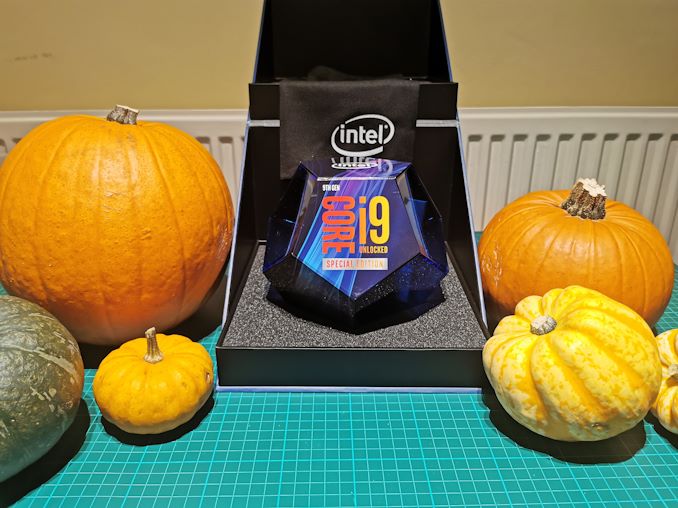The Intel Core i9-9900KS Review: The 5 GHz Consumer Special
by Dr. Ian Cutress on October 31, 2019 10:45 AM ESTConclusion
The Intel Core i9-9900KS is Intel’s first consumer level all-core 5.0 GHz processor. Technically Intel has launched an all 5.0 GHz processor before: earlier this year the Core i9-9990XE was launched into the high-frequency trading market, which had 14 cores at 5.0 GHz, but that part is an auction only part for select business partners. What the Core i9-9900KS does is bring the same principle down to a more consumer friendly core count and a more consumer friendly price point. The tray price is set at $513, although it’s likely to be sold for much more than that.
Playing To Power
One of the key elements I wanted to test in this review is how the chip responds to Turbo. As we’ve discussed at length, and confirmed by Intel: the guidelines for the Turbo settings are not set in stone. Intel actively encourages its motherboard partners to increase these settings if the motherboards are over-engineered to be able to do so. This means that a high-end motherboard should be able to give a longer turbo than a cheap board.
A longer turbo might not mean much. When the turbo budget has run out, the system will limit the chip to the TDP setting in the BIOS (which should be the one on the box), and will try and maximise the frequency for the power limit. On a lot of chips, this means you still have a very high frequency, nowhere near the base frequency. But the power limit does have benefits such as acting as a thermal control at least.
In our test, we used MSI’s Z390 Gaming Edge AC. It’s a mid-upper motherboard, but it set our Core i9-9900KS to have a TDP and turbo power limit of 255W. Intel’s ‘guidelines’ state a TDP of 127 W and a turbo power limit of 159 W. When comparing the two, there are some distinct advantages for the 255W setting, such as 10%+ performance on rendering, but the 159W setting does afford 10C lower temperatures in those heavy workloads. Ultimately, as the name TDP = Thermal Design Power implies, it all comes down on your ability to cool the chip.
For gaming, the turbo budget didn’t seem to matter at all, except in a few tests at super low resolution and settings.
One question that does remain however, is which set of results should we keep? The 255W results are what we get out of the box, and the 159W results are only 'Intel guidelines that Intel expects none of the board manufacturers to keep to'. Ideally we keep both, but that's a mess in its own right.
Planning Against The Competition
There’s no getting around giving Intel kudos for binning enough processors to commercially sell an all-core 5.0 GHz chip. In our benchmarks, we see it steaming ahead of any other consumer grade processor when it comes to single core performance. Users are likely to be able to push that single (or dual) core turbo a bit higher as well, although the power limits should be monitored.
It should be noted that in most cases, the Core i9-9900KS either matched or excelled against the previous king of Intel’s consumer desktop line, the Core i9-9900K. There were a few select instances, namely benchmarks like Handbrake, DigiCortex, F1 2018, and 7-zip, where we did see performance regressions that we weren’t expecting. We’re going to have to go back to Intel to see exactly what these are. But they seem confined to very specific workloads.
Overall, the Core i9-9900KS is Intel’s best ever consumer processor.
In ST performance metrics, it wins. In variable threaded metrics, it either wins or does really well. In MT performance metrics, it depends on how strong AMD’s 12-core hardware really is, and how multithreaded the calculation really is. As Intel slowly adds AVX-512 to its consumer line, as it is with Ice Lake, then the MT competition is going to be really interesting.
Only Available For A Short Time Only
While the Core i9-9990XE is a 14-core 5.0 GHz chip, it is an OEM only part sold by Intel at auction only, whereas the Core i9-9900KS should experience wider availability at retail, albeit for a limited time.
Our colleagues at Tom’s Hardware reported that Intel stated in a promotional video that the processor would only be available during the holiday season of 2019 – or at least that the stock level would not be replenished after the holiday season. When we approached Intel asking for confirmation, we were told:
This special edition processor will be available for a limited time only. It can be found at retailers worldwide. We are not disclosing unit quantity information. However, the Core i9-9900KS will have very limited availability.
There is no doubt that there will be some CPUs available into 2020, however it would appear that Intel is only making one main batch of hardware, and once it has gone, it has gone. This might make the $513 tray price that Intel is putting on the part a bit of a misnomer, as retailers might take advantage of this. This will take the shine off the Core i9-9900KS a little, as at $529 or so it would easily be recommended over a Core i9-9900K. If it goes to $599 or $649 because of its limited release, then it becomes less of an interesting buy.
Ultimately the Core i9-9900KS is going to end up in the hands of enthusiasts who want nothing more than the best, but don’t want to jump to the high-end desktop platform. Despite the Intel chipsets for consumers, it’s still a shame that these processors only have 16 PCIe 3.0 lanes, given the desire for direct attached PCIe storage in this market.













235 Comments
View All Comments
mattkiss - Friday, November 1, 2019 - link
The Processor Specification field in the CPU-Z screen shot has "(ES)" after the cpu name. Did you test and engineering sample or an actual retail sample?GreenReaper - Sunday, November 3, 2019 - link
It was only launched a couple of days ago, so they'd have to have had a sample, you couldn't run the tests and write the article having bought it at retail.BAF2782 - Friday, November 1, 2019 - link
Nice to see a 10+year old Thermalright True Copper: 2kg for a CPU that has a mini-nuclear thermal reactor powering itself. LoL. I can't really say much. I'm using a 11year old ZALMAN CNPS 9900MAX (300watt) AIR cooler on a 5.3GHz Golden 8700K with 1.380v in a z370 Aorus Gaming 7. I thought about getting a new cooler with the $400 open-box 9900K that i just found. But, after seeing the 9900KS running on the 10year old Thermalright True Copper: 2 kg. I don't have a doubt the ZALMAN 9900MAX (300watt) cooler will have any problems running a 5GHz (PO) 9900K.crotach - Saturday, November 2, 2019 - link
So, this is a direct competitor to 2700X, but costs twice as much?I wonder if we'll see intel as a budget offering in a couple of years, cutting the price of their 14nm tech to half of what AMD charges just to get some sales.
My my, how the tables have turned :)
Dragonstongue - Saturday, November 2, 2019 - link
if they can say 4ghs base, but 5ghz all core turbo, why not just have as 5ghz directly ??I confused, seems another marketing ploy of some sort (no real surprise there)
that being said, likely good for AMD as well as sets a new target for them TSMC et al.
Orkiton - Saturday, November 2, 2019 - link
It's like a Caterpillar engine that will need hydrogen fuel to beat most benchmarks. That means expensive Mobo, GPU, PSU, Mem, Cooler, Case.It's Intel stretching to the limits for PR purposes, yet much bellow AMD, in terms of value for money.
liquid_c - Sunday, November 3, 2019 - link
It's unbelievable, i swear. Even Anandtech's comment section has turned into a pcgamer shit show. Instead of just trying to take the article as it is - a piece of info, most of the people here either start a revolution against Intel or just plain dismiss it as "fake information" in regards to TDP. But i see nobody here admitting that Intel's 14nm is ON PAR with AMD's 7nm (i've heard they have the same density but don't quote me on that). Or that said products is not geared towards you or your acquaintances. I swear to God, it's like Intel has raped some family member or something. Just buy whatever you think is fit for you and leave others to enjoy proper journalism (which is so f*cking rare nowadays).liquid_c - Sunday, November 3, 2019 - link
*are not geared.Sigh, i miss an edit button :(
Korguz - Sunday, November 3, 2019 - link
cause it is fake info, 127 watts ?? nope, 200+ more then likely. and some i think, are tired of the lies, BS, and over charging intel has had us pay over the years. face it, if amd didnt bring out zen, the chances are we would still be stuck at quad core for the mainstream, and anything above that, would be HEDT. FYI, it may be on par, but intel should also be on 10nm by now... maybe even the next node size, and yet, intel kept saying, 10nm is on track. there are better, less expensive options then this cpu, this is just intel being intel, last ditch effort to try to save face.The Garden Variety - Sunday, November 3, 2019 - link
Thank you, liquid_c. This needs to be repeated over and over again. You have this stellar quality content, painstakingly researched and presented, and it's clear many of the readers (or at least the ones that comment) are neither understanding it, reading it in context, or even trying to think about it. The smartphone reviews are identical. It's all just "how do I read what I want so I can wage my emotional holy war because I have literally nothing else going for me."Here, I'll go one step further: there's zero reason for a site like Anandtech to have comments following articles at all. You could delete 9 out of 10 attached to this article and zero of value would be lost. Given how terribad the comment system is (no editing, tiny and unscalable input window, spam posts that go undetected for days, etc.) and the effort/investment it would likely take Anandtech's limited team to improve it, just getting the hell rid of it would be a far more sensible solution. Let the content be the star. Send people to the forums in a special board requiring a 500 post barrier in the broader community to contribute to article discussions.